Whenever you think of Jordan, you think of Petra, and also perhaps desert. But the country has so much more to offer. The hospitality is unprecedented and the landscape is overwhelmingly beautiful. Across this enchanting country lies a 675-kilometre hiking trail: the Jordan Trail. This hiking trail is the perfect guide for anyone wanting to explore Jordan. In one week, we travelled along this route from north to south straight through amazing Jordan. Jordan truly captured our hearts during this very memorable trip.
In this blog ...
- The Jordan Trail in brief
- Umm Qais: crossroads of civilisations
- Ajloun, where nature meets history
- Amman: ancient city and symbol of hospitality
- Sipping tea in Dana
- World wonder Petra; the place you can’t avoid in Jordan
- The desert of Wadi Rum
- The end of our journey across pristine Jordan
- Answers to practical questions about the Jordan Trail
- Other topics you may be interested in
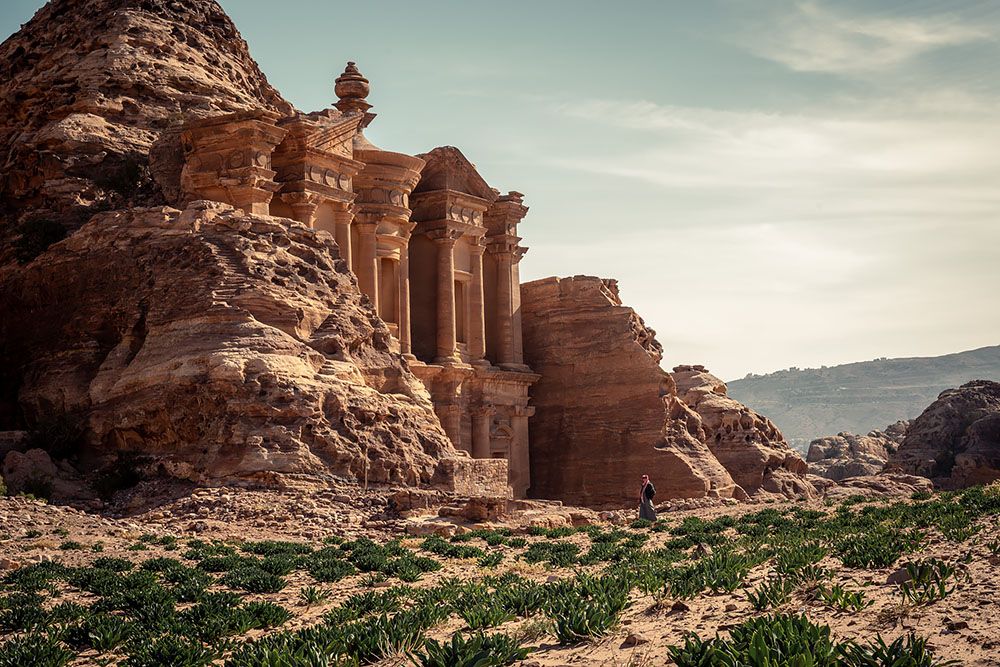
Petra Ad-Deir
The Jordan Trail in brief
The Jordan Trail starts in Umm Qais. It then heads south to Aqaba and is about 675 kilometres in length. Those who want to walk it all the way will need about a month and a half. The trail officially opened in 2017, but parts of it are old caravan routes. So, you could say the trail is centuries old! The Jordan Trail offers a variety of landscapes, flora and fauna. Our guide Ramzi likes the northernmost part best, he tells us, “Because there you have forests.” We do look forward more to the special desert landscapes in the south but that certainly does not mean that the north is not worth visiting.
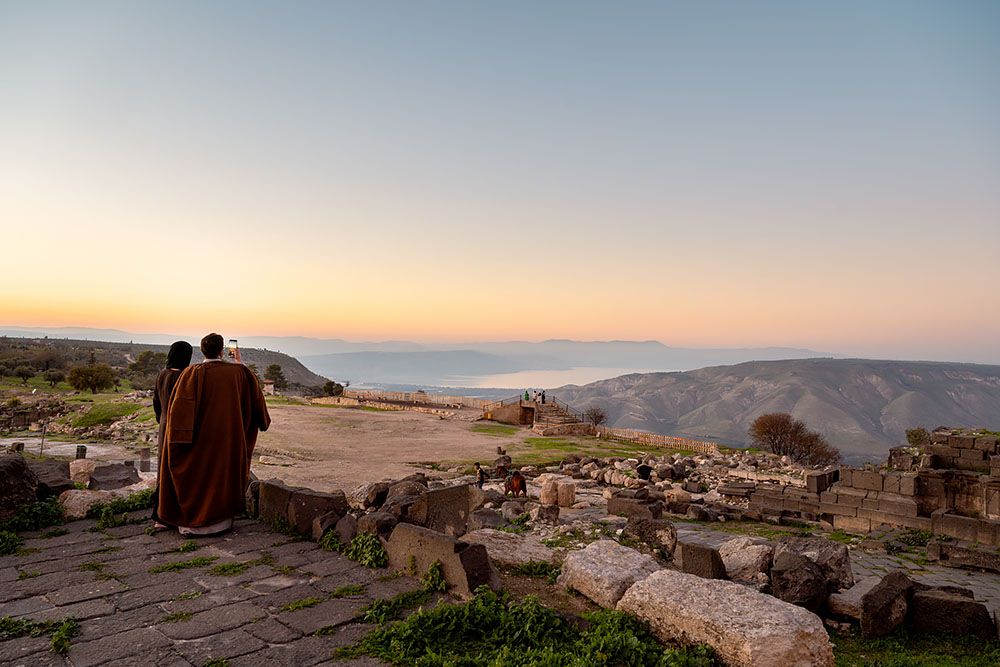
View from Um Qais with views of Israel, Lebanon and Syria in the distance
Umm Qais: crossroads of civilisations
Our journey begins in enchanting Umm Qais, located in the far north of Jordan. This archaeological site offers not only a rich history, but also breathtaking views of the Sea of Galilee, the Golan Heights and the Sea of Tiberias. Even Nazareth can be seen in the distance. On arrival, we still have an hour before the sun sets. We walk through the remains of the ancient city of Gadara. A city where 25,000 people once lived. The columns of the ruins are shrouded in the warm light of golden hour. The city seems to be coming back to life and those who daydream for a moment can effortlessly see the Romans walking here. As the sun sets, we look out over Israel, Syria and Lebanon. We are at a crossroads of civilisations. That much is clear.
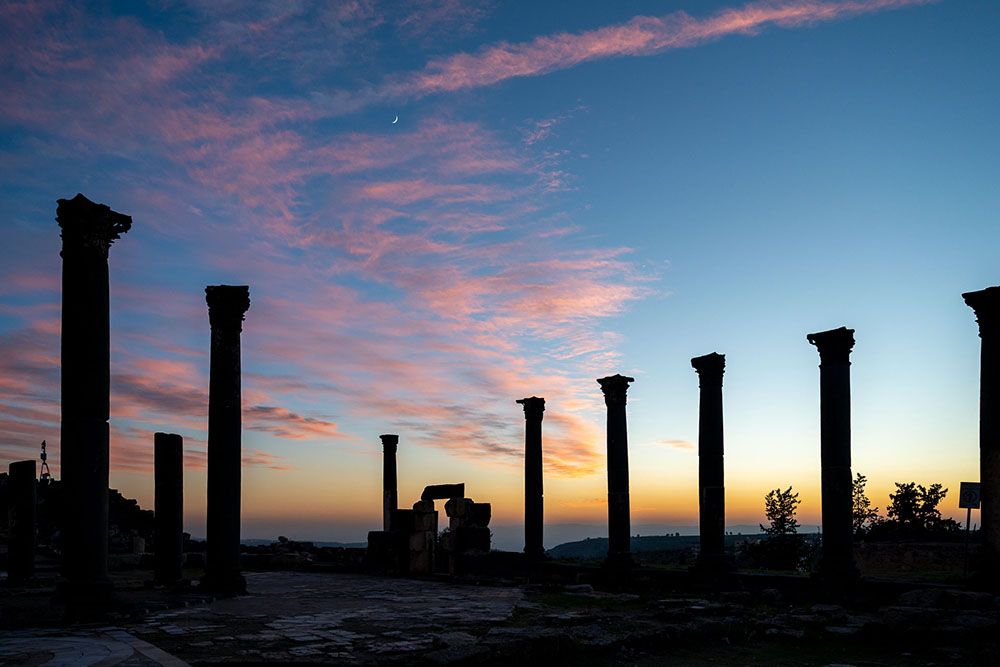
Sunset in Umm Qais
Still, let’s mention the “elephant in the room”. Currently, war is raging between Israel and the Hamas. As a result, people are understandably wondering whether it is safe to travel to Jordan. A large proportion of Jordanians are from Palestine or have Palestinian ancestors. Yet, apart from some flags (which you also see in our country), you hardly notice anything about the war. Jordan has played a neutral role during conflicts in the Middle East since the 1960s. This is respected in both the Arab and the Western world. This special geopolitical position means that even today it is still safe to travel to and through Jordan.
The next day, the journey continues to the Ziglab Dam, a hidden gem. The dam is located in a lush nature reserve. It is an ideal spot for birdwatchers and nature photographers. Here, we walk along a stretch of the Jordan Trail. Our guide Ahmad points out how this stage leads from the mountains to the lake behind the dam, continuing its way to Ajloun. The landscape here is green and full of trees. We wouldn’t necessarily call it a forest. But for a country so burdened by water scarcity, it’s quite something to see such a landscape.
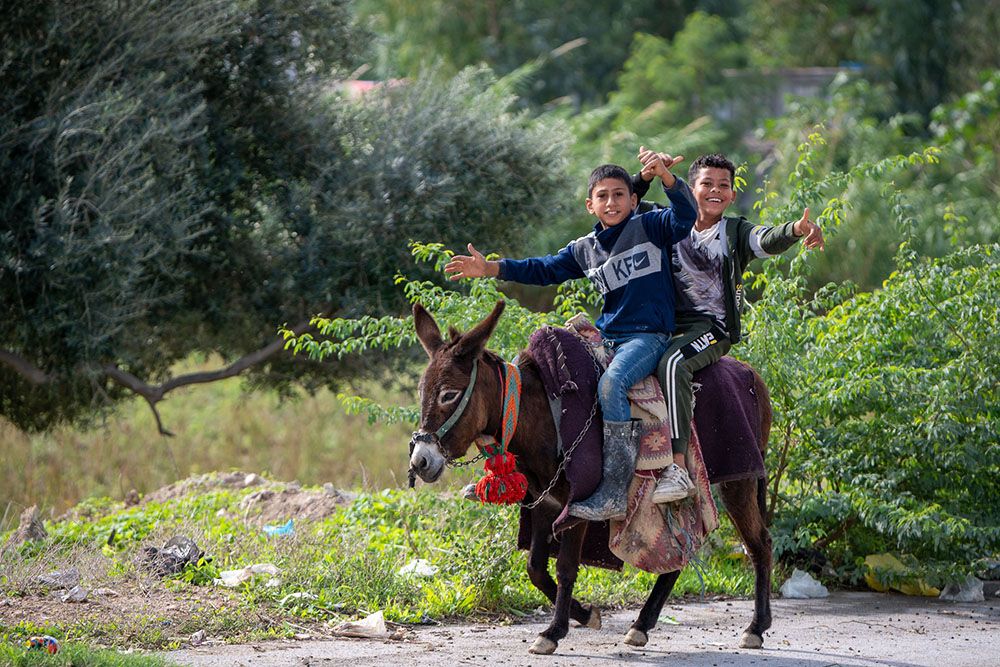
Ziglab Dam
Ajloun, where nature meets history
On the way to Ajloun, we come across a flock of sheep expertly led by boys about 10 years old. They sit together on a donkey and have great fun when they see us. As they pass by, they pose for the camera, smiling broadly. After this short photo session, we continue to the ‘Dweikat House’. There, we receive a warm welcome. In this homestay, a buffet is laid out for us with local dishes. Mr Issa Dweikat, our host, is one of the creators of the Jordan Trail and is on the board of the Jordan Trail Association.
After lunch, Mr Dweikat accompanies us. We walk together part of the stage between Rasoun and Aljloun. We descend steadily through a rocky grassy landscape, into a gorge. There are oaks around us but not as we know them. This is a species much smaller and grows in the Mediterranean world. The acorns are really the only thing that give away its species. We also see the zeeajuin growing in many places. We see this species all over Jordan, it turns out later. Even in the desert. With its large leaves, the tree is easy to spot and impossible to miss. As we approach the end of our stretch of Jordan Trail, we find ourselves among ancient olive trees. Like grandfathers with wrinkled skin, they are scattered through the landscape as we walk back into civilisation. There we say goodbye to Mr Dweikat. We cover the rest of the route to Ajloun in our bus.
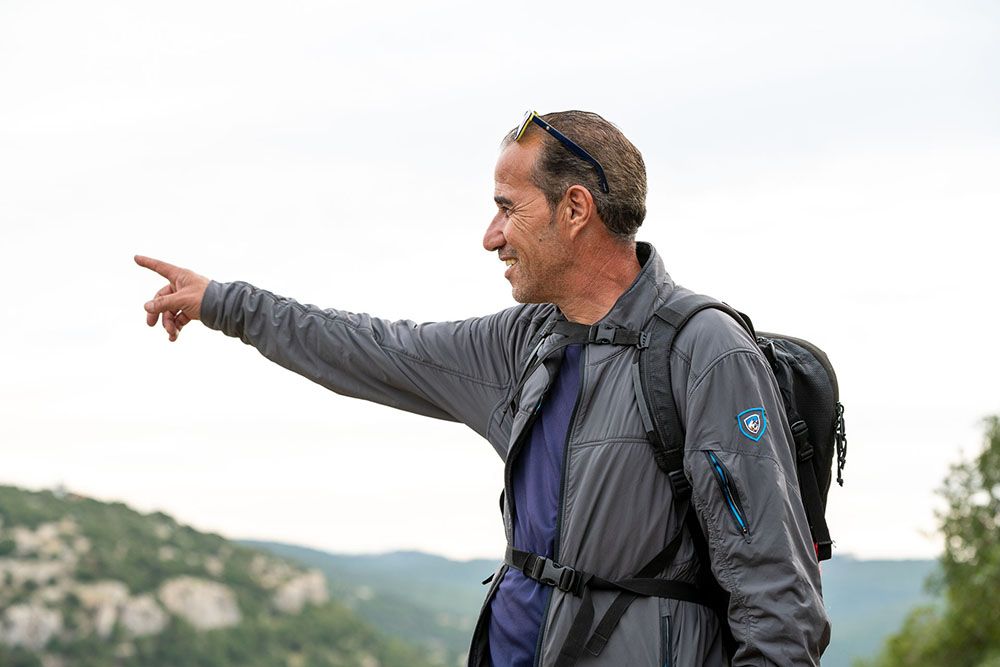
Mr. Dweikat one of the founders of the Jordan Trail
Ajloun Forest Reserve
We stay in the Ajloun Forest Reserve for the night. The cabins in the park have a comfortable bed and spacious bathroom. These cabins are managed by the RSCN. This is the national organisation that manages most major nature reserves in Jordan. There is also a short hiking trail on the grounds of the cabins. The sun is slowly setting, making it a good time to check for wildlife. The howl of the hyenas is clearly heard. But unfortunately, they do not show themselves during our walk. We settle for the nice wide views of the valley with the mountains where we walked around earlier today. As well as some birds and unusual plants, like the strawberry tree with its red bark.
Back at the park’s restaurant, a surprise awaits us: Sajiyeh. This is a traditional dish prepared on an open fire by making a cast-iron pan red-hot. Then meat and vegetables are put in. The grease splashing up ignites the flame and so tonight we eat flame-grilled chicken. After a long day, this tastes fantastic.
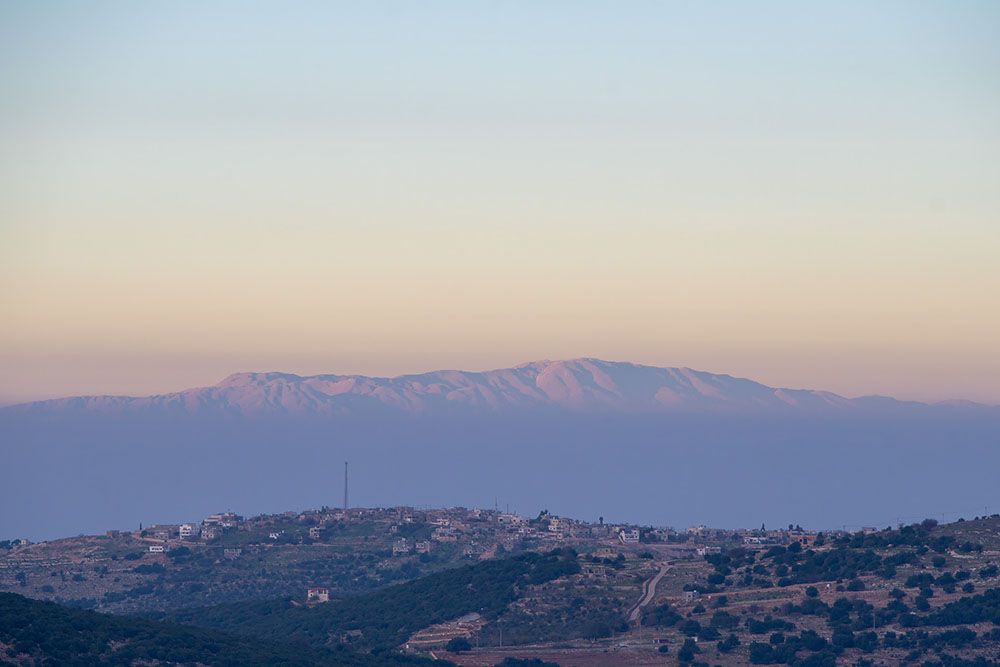
View over the Ajloun Forest Reserve
The castle of Ajloun
After this feat of nature, we slowly move back into civilisation. One of the other attractions Ajloun has is a large castle. The oldest part of this castle dates back to the 12th century and was built under the command of Sultan Salah `al-Din al Ayubi. The castle was further expanded in the 13th century. Since then, several rulers have used the castle. The last were the Ottomans who housed a military garrison there. From the top of the castle, we can see for kilometres around us. The fantastic view is also the strategic reason why the castle was built here. From here, it was easy to see the Frankish armies arriving in the 12th century.
The castle was restored after being damaged in earthquakes in the late 19th and early 20th centuries. It is a special place to walk around and you immediately imagine yourself in the Middle Ages. At the exit, we grab a freshly squeezed lemonade. Then we walk back to the taxi with scrunched up faces from the sourness. Ramzi has to laugh. “Here, you must ask if they add sugar or honey, ha-ha.” Still, the freshly squeezed lemons taste better than a juice from a supermarket back home.
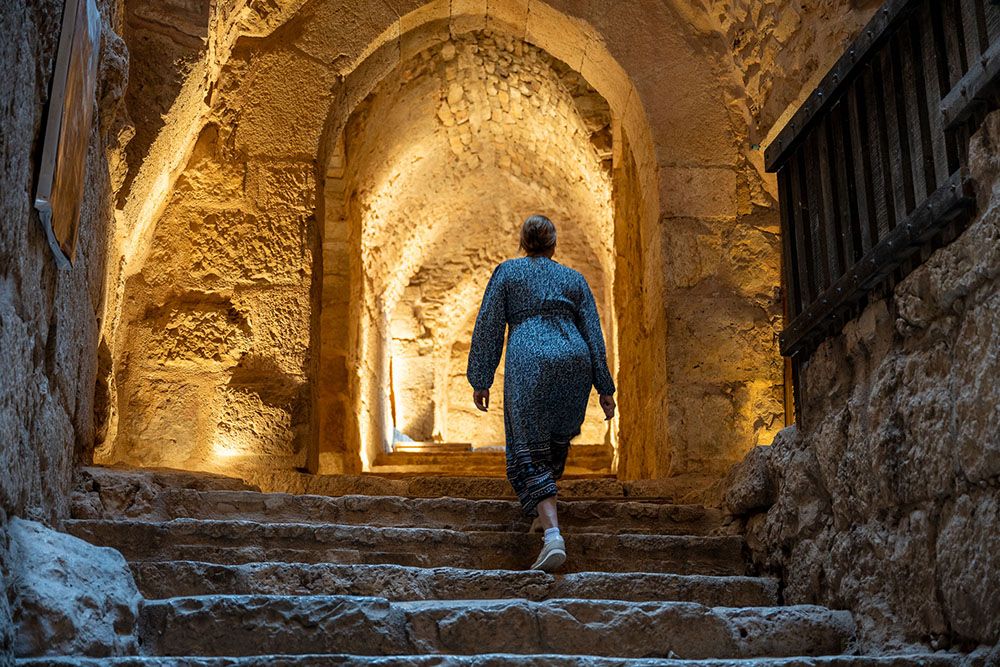
Ajloun Castle’s corridors
Amman: ancient city and symbol of hospitality
The next day we are in Amman, the capital and also the largest city in Jordan. We are given a guided tour by Annas. He is the founder of ‘Through Local Eyes’. His idea is that a city tour shouldn’t just take you past places you know how to find yourself. You can find the highlights of a city yourself. But to discover the soul of a city, you have to pass by the places where its inhabitants themselves go. So, we leave the citadel aside. Annas takes us through a maze of streets and alleys full of street art. He has something to say about almost every work of art.
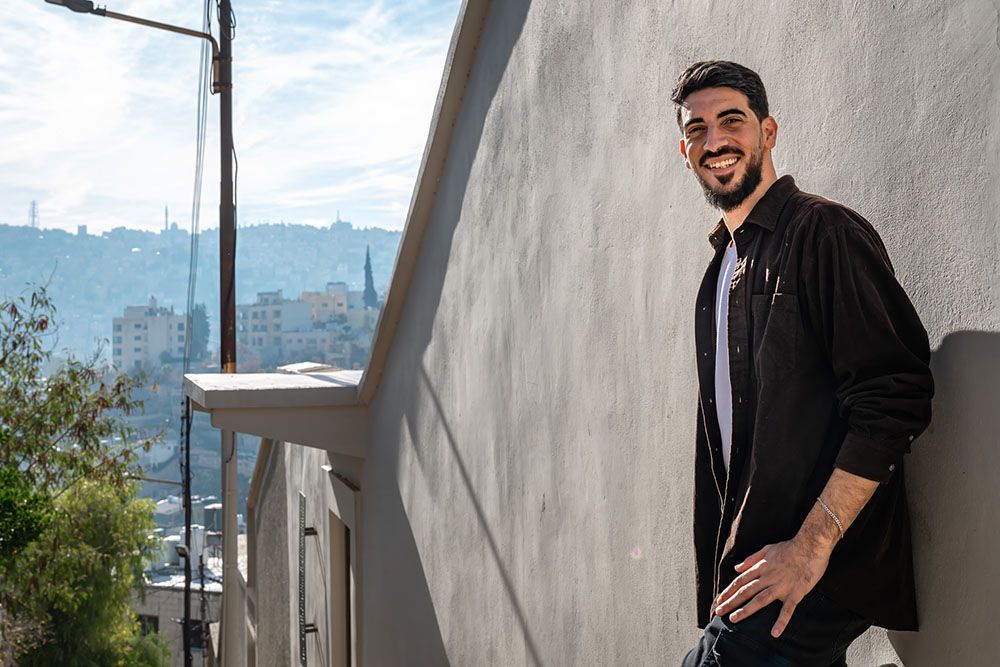
Annas, founder of Through Local Eyes
Amman is also known as the city of a million steps. It is one of those cities built on seven hills. But now it is 18 hills. The city has grown tremendously in recent years. More than four million people now live in the city itself. Whereas in 2004, there were just one million. That brings with it a whole dynamic of its own. People here are open. After all, who is really a Jordanian? Maybe the Bedouins, but they hardly live in Amman. Many people here are originally from Palestine, or their parents are from there. Many people of Iraqi origin also live here. Amman is a real melting pot. Amman has always been that way. The city is millennia old and has also always been inhabited by many peoples.
We walk down gradually and see more street art. Annas calls it cali-grafiti. We next stop at non-profit restaurant Ezwitti. Here you pay not only for your own meal but also for that of someone who cannot afford it. The little restaurant sits on the Al Kalha steps. These stairs look very photogenic thanks to the colourful street art and plants. Eventually, we arrive at the heart of the city. Here are the familiar images we know from big cities: congested traffic, merchandise on the streets and, of course, a souk. It is teeming with activity and we see fresh produce everywhere. Market merchants praise their wares and the fragrant spices overwhelm our senses. It is a completely different world from where we found ourselves yesterday.
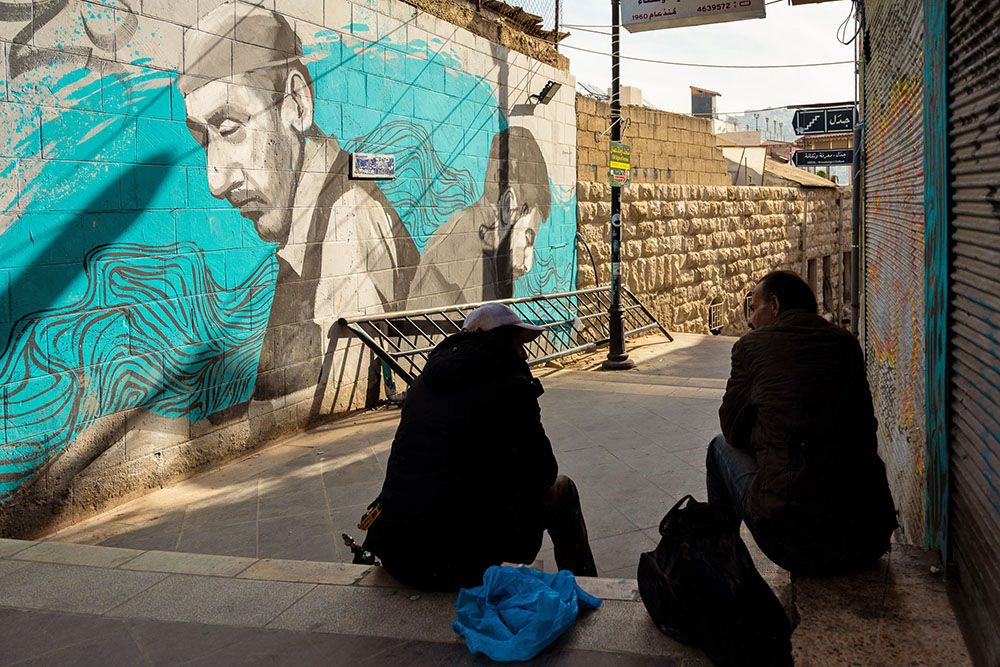
Amman is full of street art
Sipping tea in Dana
After our stay in Amman, we continue our journey southwards. Dana is our next stop. The landscape changes before our eyes as the taxi bus whizzes along the Kings Highway. It gets drier and warmer. Our final destination for today is Petra but our first stop is Dana. At the Dana Biosphere Reserve visitor centre, our guide Khaled is already waiting for us. He looks like a highwayman, somewhat like a caricature. That also suits his personality, as we find out on the way. He is full of jokes and likes to pull a goofy face for the camera. Yet he does not manage to steal attention from the breathtaking scenery. Dana is a highly biodiverse park. In front of us is a valley with sandstone cliffs: stones that have been rounded by erosion. In the distance, we can see the red rock walls full of iron and beneath our feet, the walking path becomes ever greener.
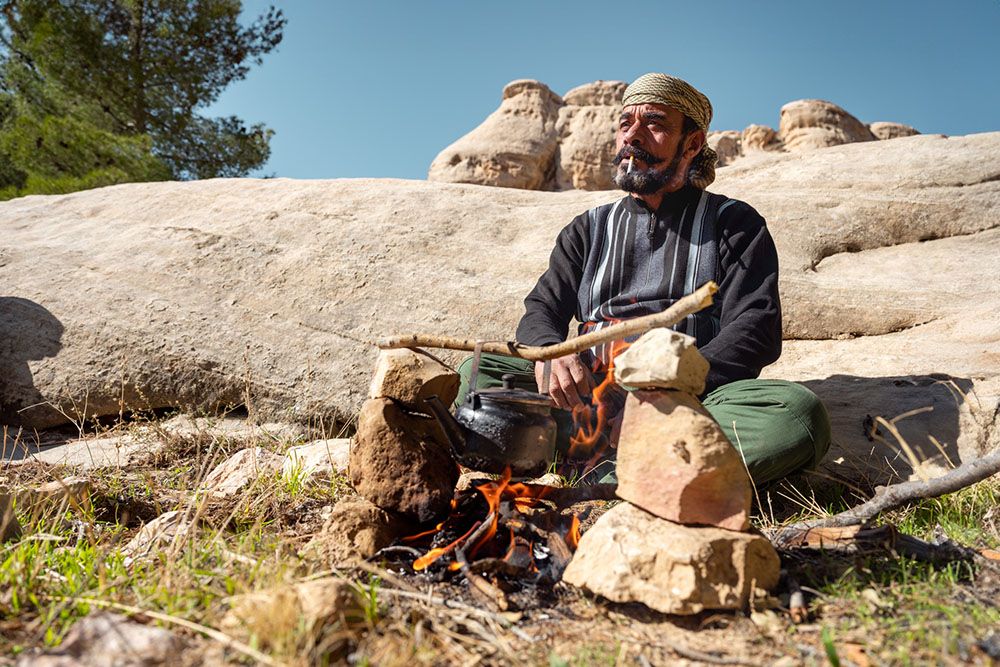
Our guide waiting patiently for the tea water to boil
After about two hours of walking, it is time for a break. At a lusciously green spot, we set our bags down for a while. Khaled gathers some wood and starts making a campfire. Subsequently, he turns out to in fact be a bushwhacker. Along the way, he collected various plants and herbs without us noticing. Not surprising of course, with this landscape around you, you look at the extraordinary panoramas more often than the guide. “Time for some delicious Dana tea,” says Khaled as he pours his herbs into the water that has just come to a boil. Anything made on a campfire tastes better and this tea is no exception. After the tea, we are recharged and walk the last bit of the hike. At the end, we board our bus again and drive to Petra in three hours. So that the following day we can start on time for perhaps the most special hike of our trip: Petra’s Backdoor Trail.
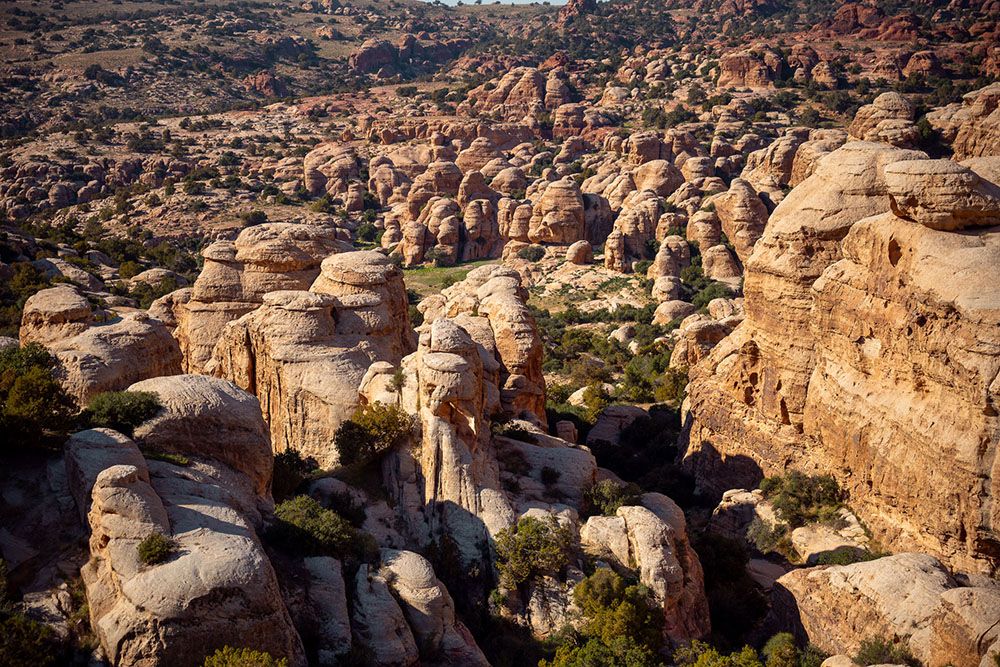
Dana’s bell jars
World wonder Petra; the place you can’t avoid in Jordan
Petra is one of the most famous and impressive archaeological sites in the world. The ancient city is also one of the highlights of the Jordan Trail. It is a fascinating example of ancient urban planning and architecture. Not for nothing is it a wonder of the world. The city is best known for its rock-hewn facades. The most famous of these is Al-Khazneh, the treasure chamber. This is the image that everyone has in mind when they think of Petra. We are a bit more active-minded and so we don’t enter through the front entrance but go in the back. In a walk of about 14 kilometres, you then eventually arrive at the treasure chamber. This walk is very rewarding and makes us feel like we are playing a small part in an Indiana Jones film.
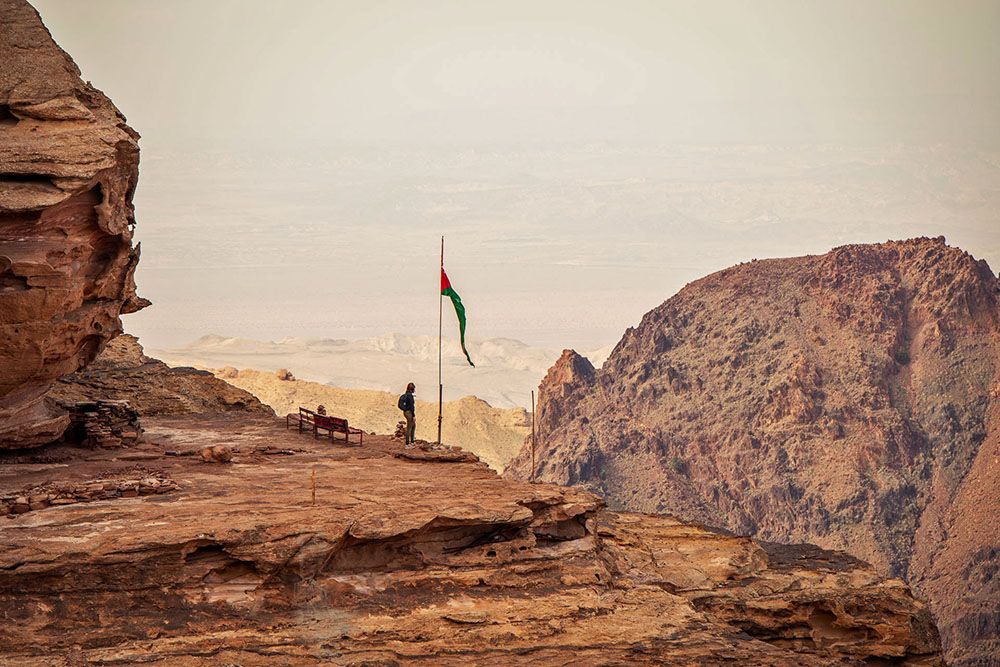
Enjoy Spectacular views as you hike Petra’s Backdoor Trail
When we finally arrive at the treasure chamber, we feast our eyes. It is an immense facade carved so smoothly that your mouth really falls open for a moment. We wonder in despair how it could have been done so smoothly. A plasterer would be jealous. We walk a little further towards the main entrance as most people enter. It is as if the veils are pulled away one by one and the treasure chamber reveals itself. Phenomenal natural beauty combined with millennia-old architecture. Truly world wonder worthy.
We will soon come to this travel blog with a separate blog writing in detail about our hike via Petra’s Backdoor Trail.
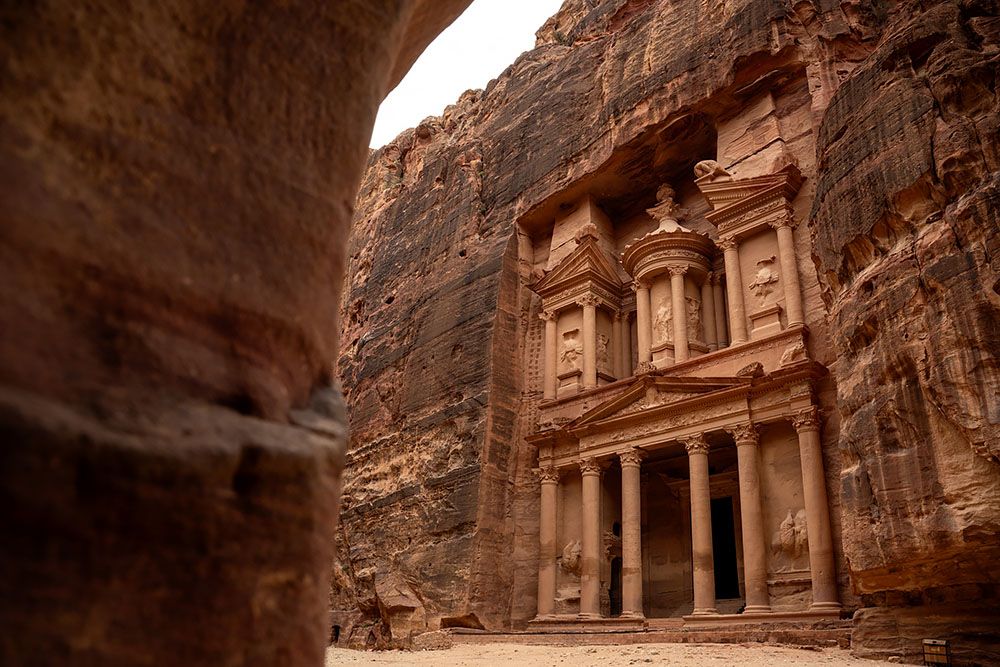
Petra’s “treasure chamber”
The desert of Wadi Rum
The last stop of the trip is the desert. Wadi Rum is famous, literally. It is where parts of films like The Martian and, of course, Lawrence of Arabia were shot. On the way to Sun City Camp, we already see several other encampments. The spherical tents are reminiscent of images familiar from science fiction films. Sun City Camp also has the requisite spheres, but we are staying in a more Bedouin-like tent tonight. At least, that’s what it looks like from the outside. It is basically a luxury glamping location where you lack very little. You can also stay more sober here and even stay in a real Bedouin camp.
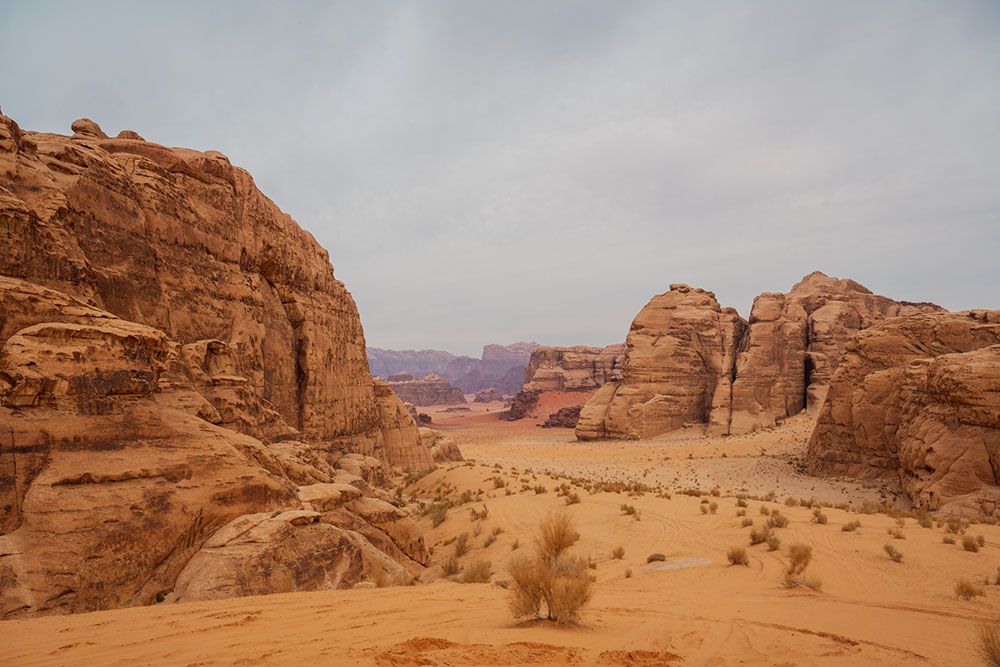
The colours of the desert
The Jordan Trail crosses Wadi Rum. So, you can go here on foot but keep in mind that it can get incredibly hot. We quickly jump on the back of a pick-up upon arrival to drive to a point for sunset. Unfortunately, the weather is not cooperating. It is a bit cloudy so we don’t get the spectacular sunset we had hoped for. Unfortunately, that means there won’t be many stars to see tonight either. We do set the alarm for half past six, hoping for a better sunrise. It is chilly and dark when we step outside. Not a blemish in the sky by the looks of it. Slowly it gets lighter and we see the sun, the sky and the mountains colouring in. The yellow sand beneath the red rocks against the backdrop of a blue sky. A spectacle to behold.
Two hours later, we are again in the back of the pick-up. We are shown around by Brenda, a Dutch woman who lives here in the desert. She takes us to some special places in the desert. She really loves the desert herself she tells us. She shows us ancient rock drawings and also popular photo spots. We get to see how diverse the landscape actually is. That there are different colours of sand and there are also green patches. Vastness takes on a new meaning here. We feast our eyes on it all yet again.
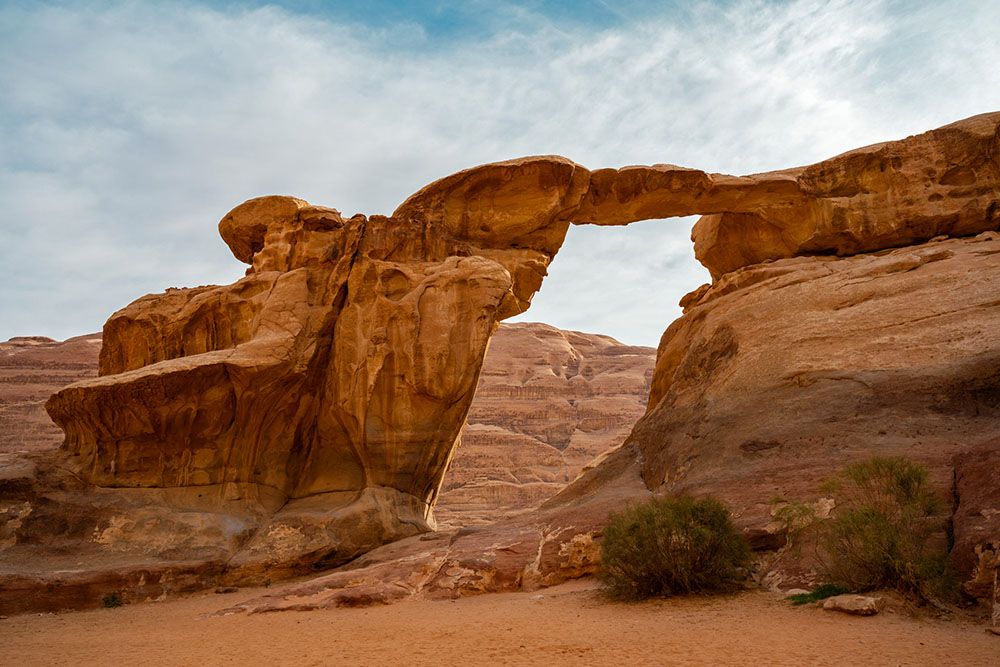
Um Frouth Rock Bridge, Wadi Rum
The end of our journey across pristine Jordan
Our journey across Jordan is almost over. As we rock back and forth on the back of the pick-up and approach Sun City Camp, we take another good look around us. What a force of nature. For someone who loves an active destination full of overwhelming landscapes and hospitality, Jordan is the ideal destination. We do understand that many fairy tales come from the Middle East. From the sunset in Umm Qais to the sunrise in the desert, Jordan is enchantingly beautiful.
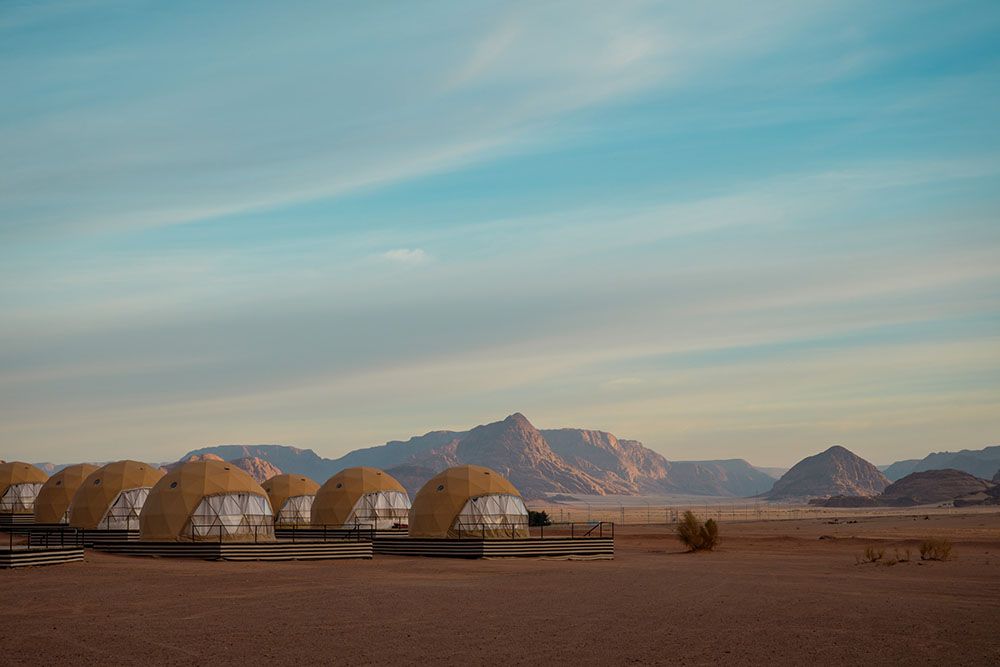
Sunrise at Sun City Camp, glamping in the desert
Answers to practical questions about the Jordan Trail
The "Jordan Trail" is a long-distance hiking trail in Jordan. It offers a unique combination of natural landscapes, cultural and historical sites, including Petra and Wadi Rum. This route traverses diverse terrain, from green forests and valleys in the north to the iconic desert landscapes in the south.
The Jordan Trail starts in Umm Qais, on the border with Syria, Israel and Lebanon. It ends in Aqaba on the Red Sea.
The Jordan Trail is 675 kilometres in total and if you want to hike it all the way, it will take you at least 40 days. Many people choose to hike parts of the Jordan Trail. Unfortunately, we were only there for a week. Therefore, we were only able to hike some small parts of the following stages: Umm Qais - Ziglab, Rasoun - Ajloun, Little Petra - Petra, via the ‘Backdoor Trail’.
Jordan has always been one of the safest countries in the Middle East. This is mainly because they have good relations with both Israel and the Arab world. So, Jordan is neutral, which (even in turbulent times) makes it a safe country to travel in.
Jordan can be travelled all year round. Of course, it can get very hot in summer, especially in the desert. So, the best time is in spring or autumn. We ourselves were there in December and even then, it was doable. There’s only a slight chance of rain then.
More information on the Jordan Trail can be found at www.jordantrail.org. For more general info on Jordan, please visit www.visitjordan.com.
In fact, you cannot avoid the Jordan Trail when travelling to Jordan. This is simply because the trail takes you past all the country's highlights. There are many tour operators offering hiking tours in Jordan, such as Green Arrow Tours, Experience Jordan Adventures and Discover Jordan. These tour operators usually focus on the southern part of the Trail, from Dana to Wadi Rum for example.
Of course, it is also possible to travel more independently. Royal Jordanian Airlines fly to Amman and/or Aqaba several times a week. From there, you can rent a car and explore the country on your own. It is also possible to book with a local tour operator, such as JoNavigators. They can tailor-make a trip for you or join you as a guide. The trail itself is not well marked everywhere so to do solo long stages you need experience. Also bear in mind that water is scarce in Jordan and keep that in mind when setting off.
At the invitation of the Jordan Tourism Board, we explored the Jordan Trail across Jordan. We compiled the content of the blog independently and objectively based on our own impressions.


